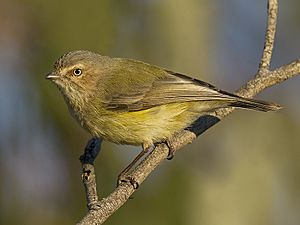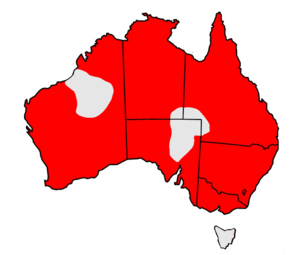Weebill facts for kids
Quick facts for kids Weebill |
|
|---|---|
 |
|
| Nominate subspecies, Victoria | |
| Conservation status | |
| Scientific classification | |
| Genus: |
Smicrornis
|
| Species: |
brevirostris
|
 |
|
| Approximate range in Australia
Year-round range |
|
The weebill (Smicrornis brevirostris) is a tiny bird found all over mainland Australia. It belongs to the Acanthizidae family. This bird mainly eats insects and is known as a passerine (a type of perching bird).
At only about 8 to 9 centimeters (3 to 3.5 inches) long, the weebill is Australia's smallest bird! It was first described by a scientist named John Gould in 1838. There are four different types, or subspecies, of the weebill.
Weebills have simple colors. Their upper parts are olive-grey, and their undersides are lighter and more yellowish. Birds in southern Australia tend to be more brownish, while those in tropical areas are more yellow.
Contents
Weebill: How It Got Its Name
The weebill was first described by John Gould in 1838. He called it Psilopus brevirostris. The name brevirostris comes from Latin words meaning "short beak." This describes the bird's small bill.
In 1843, Gould created a new group, or genus, just for this bird. He named it Smicrornis. This name comes from Greek words meaning "small bird." The weebill is the only bird in the Smicrornis genus.
People used to call this bird other names, like "tree-tit" or "scrub-tit." But in 1926, "weebill" became its official name.
Different Types of Weebills
There are four main types, or subspecies, of the weebill. They live in different parts of Australia:
- S. b. flavescens: Found across Northern Australia, from the Kimberley region to northern Queensland.
- S. b. ochrogaster: Lives in western and central Western Australia.
- S. b. occidentalis: Found in southwest Western Australia and eastward around the Nullarbor Plain to South Australia.
- S. b. brevirostris: This is the original type. It lives in Eastern Australia, from central Queensland down to Victoria and southeast South Australia.
Weebill: What It Looks Like
The weebill is Australia's smallest bird. It is about 8 to 9 centimeters (3 to 3.5 inches) long. An adult weebill weighs about 6 grams (0.2 ounces). Its wingspan is around 15 centimeters (6 inches).
Weebills have feathers that are not very bright. Their colors range from yellowish-grey on the front to olive-brownish-grey on the back. The exact color can change depending on where the bird lives.
Adult weebills have pale yellow eyes. They also have a faint cream-colored stripe above their eyes. Their throat feathers are grey, sometimes with thin lines. The flight feathers on their wings are pale brown.
Their tail feathers are brown with a black bar and a white spot on the tip. Both male and female weebills look the same in terms of feather colors.
The weebill's bill is short and pale grey. This stubby bill helps tell it apart from other similar birds called thornbills. Their legs and feet are grey. Like other perching birds, their toes are arranged to help them grip branches.
Young weebills look a lot like adults. However, you can tell them apart by their brighter, yellow bill and greyer eyes.
The weebill has a loud, clear, and musical voice. You can often hear its calls from far away. They sound like "pee-pee p'wee," "wee bit," or "wee willy weetee."
Where Weebills Live
Weebills live in woodlands and forests across most of mainland Australia. They are not found in Tasmania. All four types of weebills stay in their home areas all year round. Their numbers usually remain steady.
These birds are most often found high up in the trees of dry, open eucalyptus forests and woodlands. They sometimes come lower to find food. They prefer to search for insects in the leaves of healthy eucalyptus trees.
Weebills live in all kinds of climates. In very dry areas, they tend to stay near water sources. They often hang out with other small birds that eat insects, like thornbills and pardalotes.
Weebill: What It Eats and How It Lives
Weebill Diet
Weebills mainly eat insects and their young (larvae). Sometimes they will also eat seeds. They eat spiders, beetles, and flies.
Weebills are busy eaters. They usually forage in pairs or small groups of up to 8 birds. They mostly look for food in trees. They often hover in the air or cling to small branches. They pick insects off the outer leaves of trees.
Weebills help keep trees healthy. They eat tiny insects like scale insects and psyllids. Psyllids make a sugary cover called a "lerp," which weebills also enjoy eating.
Weebill Life Cycle and Reproduction
Weebills build dome-shaped nests that hang from branches. They make their nests from thin, bendy materials like grasses and plant fibers. They hide their nests in the thick leaves of tree canopies. Weebills also use spiderwebs, insect cocoons, and animal hair to make their nests strong and even harder to see.
The time of year when weebills breed depends on where they live and the weather. They can breed almost any time, but most often from July to May. During courtship, male weebills may fluff up their cheek and head feathers and stretch out their wings to the female. Both male and female weebills might fan their tails, bow slightly, and quiver their wings at the nest site.
The female weebill usually lays two to four cream-colored eggs with brown speckles. The eggs are oval-shaped. Only the female sits on the eggs to keep them warm. They hatch after 10 to 12 days. After the chicks hatch, both parents take care of them.
Sometimes, other birds try to trick weebills into raising their young. For example, the Horsfield's bronze-cuckoo might remove weebill eggs from the nest. Then, the cuckoo lays one or two of its own eggs for the weebill parents to raise.
Weebill: Threats and Conservation
The weebill is common in Australia and is not considered endangered. It is listed as "Least Concern" by the IUCN Red List of Threatened Species.
However, like many woodland birds in Australia, weebill numbers have gone down in some local areas. This happens because their homes (habitats) are being lost or broken up. This is often due to trees being cut down in eucalyptus woodlands. Other changes to the land made by humans also affect them.
Human activities can also introduce new plants and animals that harm weebills. Changes in how fires are managed can also affect the environment. These changes can alter the structure of their habitat and impact the birds living there.
See also
 In Spanish: Gerigón piquicorto para niños
In Spanish: Gerigón piquicorto para niños



